RENAULT KANGOO ZERO EMISSION 2012 X61 / 2.G Owners Manual
Manufacturer: RENAULT, Model Year: 2012, Model line: KANGOO ZERO EMISSION, Model: RENAULT KANGOO ZERO EMISSION 2012 X61 / 2.GPages: 213, PDF Size: 6.08 MB
Page 151 of 213
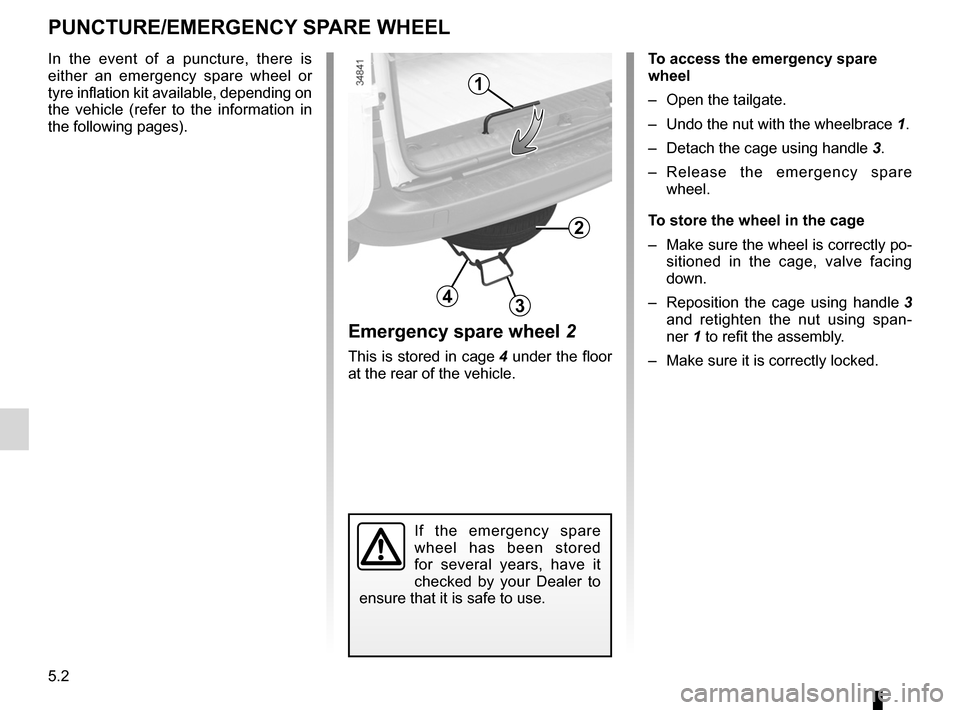
emergency spare wheel ........................................ (current page)
5.2
ENG_UD25341_3
Roue de secours (X61 - F61 - K61 - Renault)
ENG_NU_911-4_F61e_Renault_5
Puncture
Emergency spare wheel
Puncture/emergency sP are wheel
to access the emergency spare
wheel
– Open the tailgate.
– Undo the nut with the wheelbrace 1.
– Detach the cage using handle 3.
– Release the emergency spare
wheel.
t o store the wheel in the cage
– Make sure the wheel is correctly po-
sitioned in the cage, valve facing
down.
– Reposition the cage using handle 3
and retighten the nut using span -
ner 1 to refit the assembly.
– Make sure it is correctly locked.
If the emergency spare
wheel has been stored
for several years, have it
checked by your Dealer to
ensure that it is safe to use.
2
3
1
emergency spare wheel 2
This is stored in cage 4 under the floor
at the rear of the vehicle.
4
In the event of a puncture, there is
either an emergency spare wheel or
tyre inflation kit available, depending on
the vehicle (refer to the information in
the following pages).
Page 152 of 213
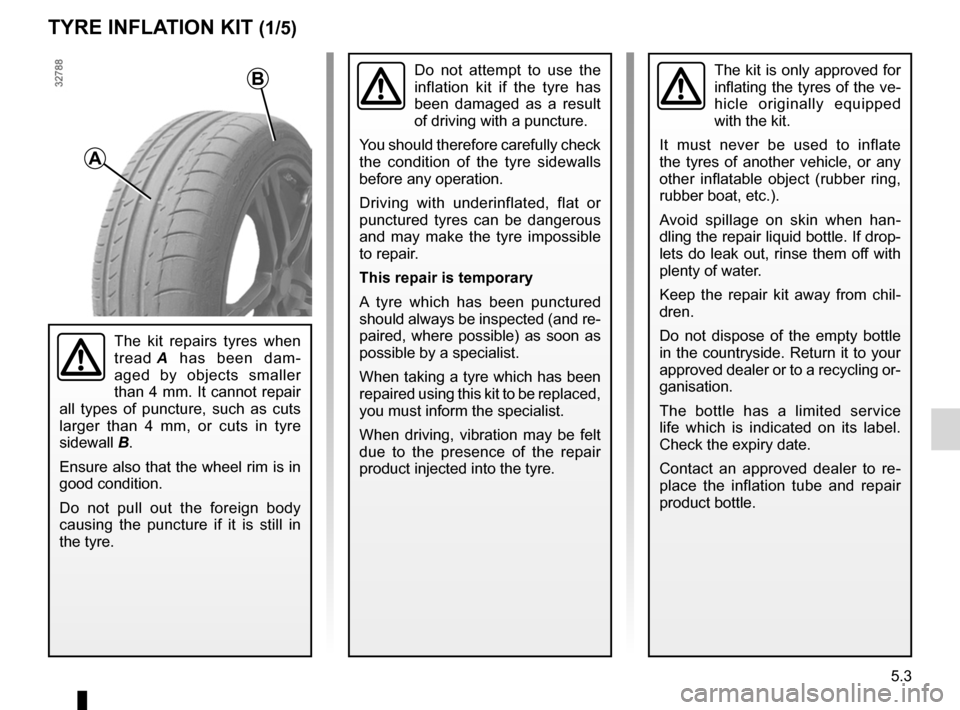
tyre inflation kit...................................... (up to the end of the DU)
5.3
ENG_UD28662_1
Kit de gonflage des pneumatiques (X61 électrique - Renault)
ENG_NU_911-4_F61e_Renault_5
Tyre inflation kit
tyre InFlatIOn KIt (1/5)
The kit is only approved for
inflating the tyres of the ve-
hicle originally equipped
with the kit.
It must never be used to inflate
the tyres of another vehicle, or any
other inflatable object (rubber ring,
rubber boat, etc.).
Avoid spillage on skin when han -
dling the repair liquid bottle. If drop-
lets do leak out, rinse them off with
plenty of water.
Keep the repair kit away from chil -
dren.
Do not dispose of the empty bottle
in the countryside. Return it to your
approved dealer or to a recycling or-
ganisation.
The bottle has a limited service
life which is indicated on its label.
Check the expiry date.
Contact an approved dealer to re -
place the inflation tube and repair
product bottle.
a
B
The kit repairs tyres when
tread A has been dam -
aged by objects smaller
than 4 mm. It cannot repair
all types of puncture, such as cuts
larger than 4 mm, or cuts in tyre
sidewall B.
Ensure also that the wheel rim is in
good condition.
Do not pull out the foreign body
causing the puncture if it is still in
the tyre.
Do not attempt to use the
inflation kit if the tyre has
been damaged as a result
of driving with a puncture.
You should therefore carefully check
the condition of the tyre sidewalls
before any operation.
Driving with underinflated, flat or
punctured tyres can be dangerous
and may make the tyre impossible
to repair.
this repair is temporary
A tyre which has been punctured
should always be inspected (and re-
paired, where possible) as soon as
possible by a specialist.
When taking a tyre which has been
repaired using this kit to be replaced,
you must inform the specialist.
When driving, vibration may be felt
due to the presence of the repair
product injected into the tyre.
Page 153 of 213
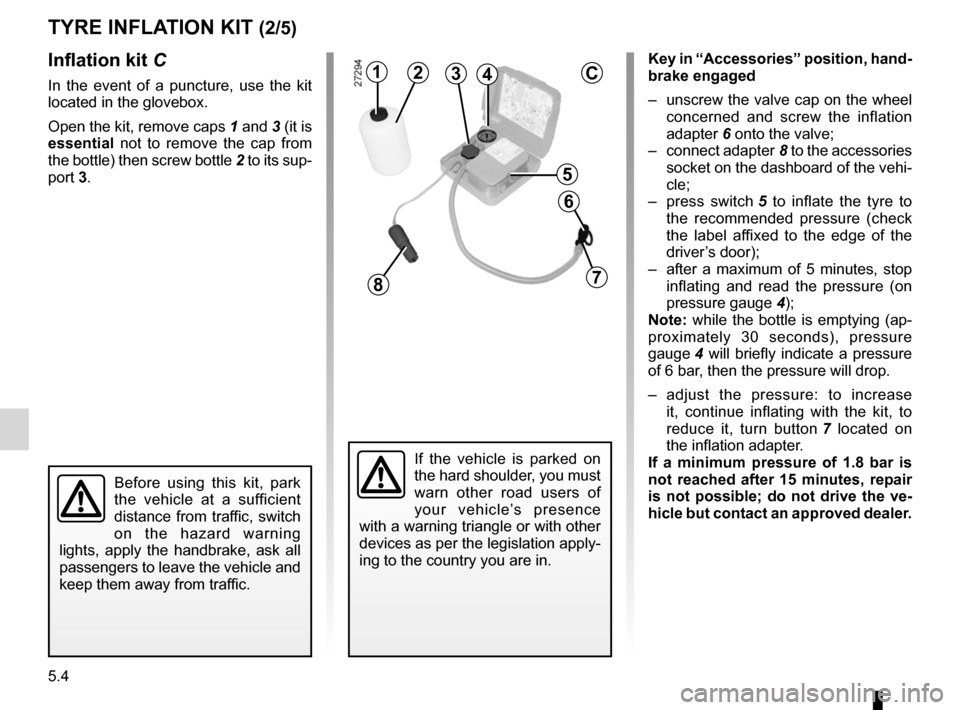
5.4
ENG_UD28662_1
Kit de gonflage des pneumatiques (X61 électrique - Renault)
ENG_NU_911-4_F61e_Renault_5
Jaune NoirNoir texte
Inflation kit C
In the event of a puncture, use the kit
located in the glovebox.
Open the kit, remove caps 1 and 3 (it is
essential not to remove the cap from
the bottle) then screw bottle 2 to its sup-
port 3.
tyre InFlatIOn KIt (2/5)
143
5
6
78
2Key in “accessories” position, hand-
brake engaged
– unscrew the valve cap on the wheel
concerned and screw the inflation
adapter 6 onto the valve;
– connect adapter 8 to the accessories
socket on the dashboard of the vehi-
cle;
– press switch 5 to inflate the tyre to
the recommended pressure (check
the label affixed to the edge of the
driver’s door);
– after a maximum of 5 minutes, stop
inflating and read the pressure (on
pressure gauge 4);
note: while the bottle is emptying (ap-
proximately 30 seconds), pressure
gauge 4 will briefly indicate a pressure
of 6 bar, then the pressure will drop.
– adjust the pressure: to increase
it, continue inflating with the kit, to
reduce it, turn button 7 located on
the inflation adapter.
If a minimum pressure of 1.8 bar is
not reached after 15 minutes, repair
is not possible; do not drive the ve-
hicle but contact an approved dealer.
Before using this kit, park
the vehicle at a sufficient
distance from traffic, switch
on the hazard warning
lights, apply the handbrake, ask all
passengers to leave the vehicle and
keep them away from traffic.
If the vehicle is parked on
the hard shoulder, you must
warn other road users of
your vehicle’s presence
with a warning triangle or with other
devices as per the legislation apply-
ing to the country you are in.
c
Page 154 of 213
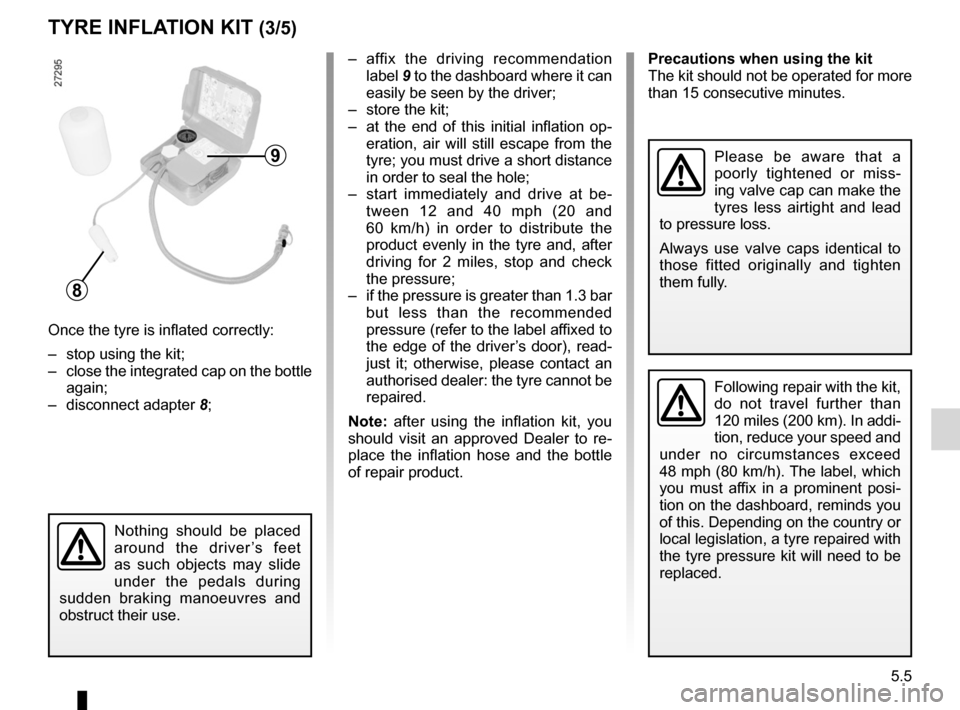
JauneNoirNoir texte
5.5
ENG_UD28662_1
Kit de gonflage des pneumatiques (X61 électrique - Renault)
ENG_NU_911-4_F61e_Renault_5
tyre InFlatIOn KIt (3/5)
9
8
Precautions when using the kit
The kit should not be operated for more
than 15 consecutive minutes.
Once the tyre is inflated correctly:
– stop using the kit;
– close the integrated cap on the bottle
again;
– disconnect adapter 8; –
affix the driving recommendation
label 9 to the dashboard where it can
easily be seen by the driver;
– store the kit;
– at the end of this initial inflation op -
eration, air will still escape from the
tyre; you must drive a short distance
in order to seal the hole;
– start immediately and drive at be -
tween 12 and 40 mph (20 and
60 km/h) in order to distribute the
product evenly in the tyre and, after
driving for 2 miles, stop and check
the pressure;
– if the pressure is greater than 1.3 bar
but less than the recommended
pressure (refer to the label affixed to
the edge of the driver’s door), read-
just it; otherwise, please contact an
authorised dealer: the tyre cannot be
repaired.
n ote: after using the inflation kit, you
should visit an approved Dealer to re -
place the inflation hose and the bottle
of repair product.
Following repair with the kit,
do not travel further than
120 miles (200 km). In addi -
tion, reduce your speed and
under no circumstances exceed
48 mph (80 km/h). The label, which
you must affix in a prominent posi -
tion on the dashboard, reminds you
of this. Depending on the country or
local legislation, a tyre repaired with
the tyre pressure kit will need to be
replaced.
Nothing should be placed
around the driver ’s feet
as such objects may slide
under the pedals during
sudden braking manoeuvres and
obstruct their use.
Please be aware that a
poorly tightened or miss -
ing valve cap can make the
tyres less airtight and lead
to pressure loss.
Always use valve caps identical to
those fitted originally and tighten
them fully.
Page 155 of 213
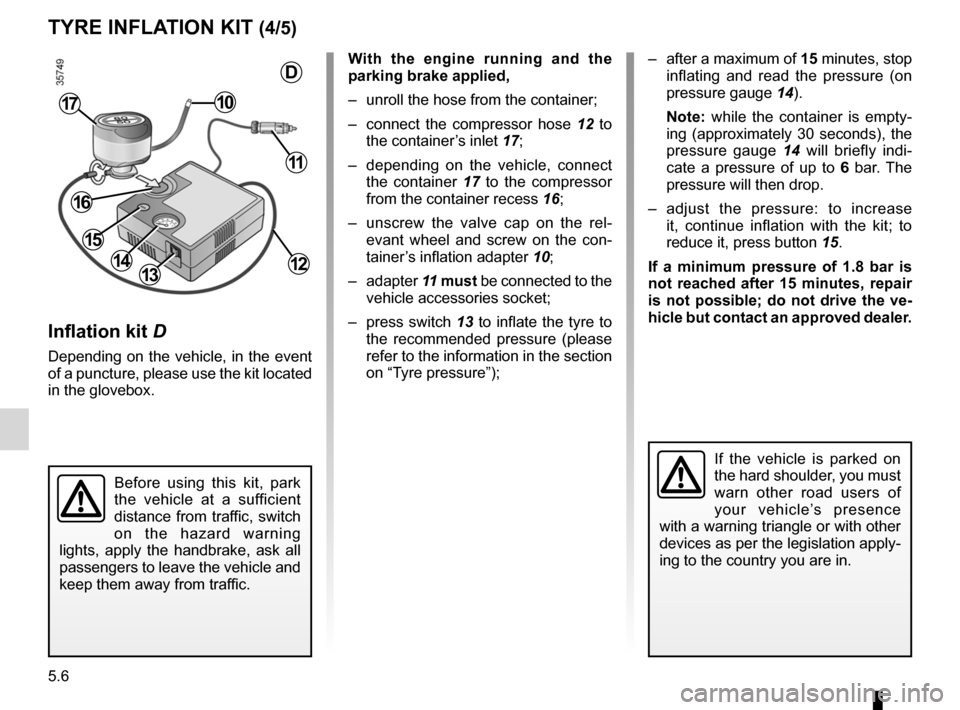
5.6
ENG_UD28662_1
Kit de gonflage des pneumatiques (X61 électrique - Renault)
ENG_NU_911-4_F61e_Renault_5
Jaune NoirNoir texte
tyre InFlatIOn KIt (4/5)
Inflation kit D
Depending on the vehicle, in the event
of a puncture, please use the kit located
in the glovebox.
Before using this kit, park
the vehicle at a sufficient
distance from traffic, switch
on the hazard warning
lights, apply the handbrake, ask all
passengers to leave the vehicle and
keep them away from traffic.
If the vehicle is parked on
the hard shoulder, you must
warn other road users of
your vehicle’s presence
with a warning triangle or with other
devices as per the legislation apply-
ing to the country you are in.
w ith the engine running and the
parking brake applied,
– unroll the hose from the container;
– connect the compressor hose 12 to
the container’s inlet 17;
– depending on the vehicle, connect
the container 17 to the compressor
from the container recess 16;
– unscrew the valve cap on the rel -
evant wheel and screw on the con -
tainer’s inflation adapter 10;
– adapter 11 must be connected to the
vehicle accessories socket;
– press switch 13 to inflate the tyre to
the recommended pressure (please
refer to the information in the section
on “Tyre pressure”);
1314
1017
– after a maximum of 15 minutes, stop
inflating and read the pressure (on
pressure gauge 14).
n ote: while the container is empty -
ing (approximately 30 seconds), the
pressure gauge 14 will briefly indi -
cate a pressure of up to 6 bar. The
pressure will then drop.
– adjust the pressure: to increase
it, continue inflation with the kit; to
reduce it, press button 15.
If a minimum pressure of 1.8 bar is
not reached after 15 minutes, repair
is not possible; do not drive the ve-
hicle but contact an approved dealer.
11
12
16
15
D
Page 156 of 213
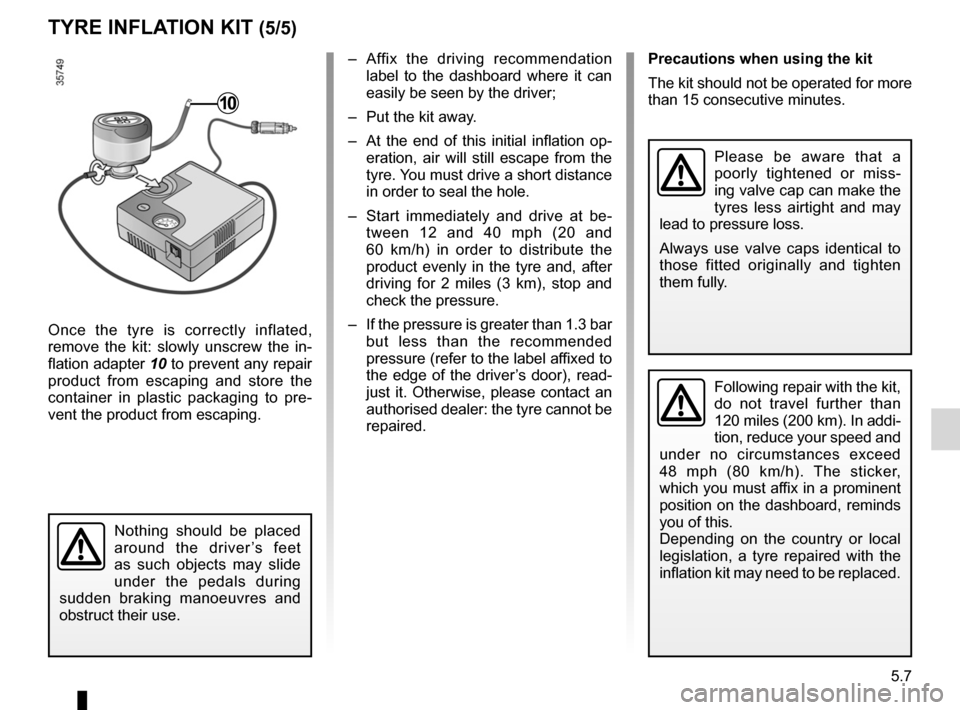
JauneNoirNoir texte
5.7
ENG_UD28662_1
Kit de gonflage des pneumatiques (X61 électrique - Renault)
ENG_NU_911-4_F61e_Renault_5
tyre InFlatIOn KIt (5/5)
Once the tyre is correctly inflated,
remove the kit: slowly unscrew the in -
flation adapter 10 to prevent any repair
product from escaping and store the
container in plastic packaging to pre -
vent the product from escaping.
– Affix the driving recommendation
label to the dashboard where it can
easily be seen by the driver;
– Put the kit away.
– At the end of this initial inflation op-
eration, air will still escape from the
tyre. You must drive a short distance
in order to seal the hole.
– Start immediately and drive at be -
tween 12 and 40 mph (20 and
60 km/h) in order to distribute the
product evenly in the tyre and, after
driving for 2 miles (3 km), stop and
check the pressure.
– If the pressure is greater than 1.3 bar
but less than the recommended
pressure (refer to the label affixed to
the edge of the driver’s door), read-
just it. Otherwise, please contact an
authorised dealer: the tyre cannot be
repaired. Precautions when using the kit
The kit should not be operated for more
than 15 consecutive minutes.
Nothing should be placed
around the driver ’s feet
as such objects may slide
under the pedals during
sudden braking manoeuvres and
obstruct their use.
10
Please be aware that a
poorly tightened or miss -
ing valve cap can make the
tyres less airtight and may
lead to pressure loss.
Always use valve caps identical to
those fitted originally and tighten
them fully.
Following repair with the kit,
do not travel further than
120 miles (200 km). In addi -
tion, reduce your speed and
under no circumstances exceed
48 mph (80 km/h). The sticker,
which you must affix in a prominent
position on the dashboard, reminds
you of this.
Depending on the country or local
legislation, a tyre repaired with the
inflation kit may need to be replaced.
Page 157 of 213
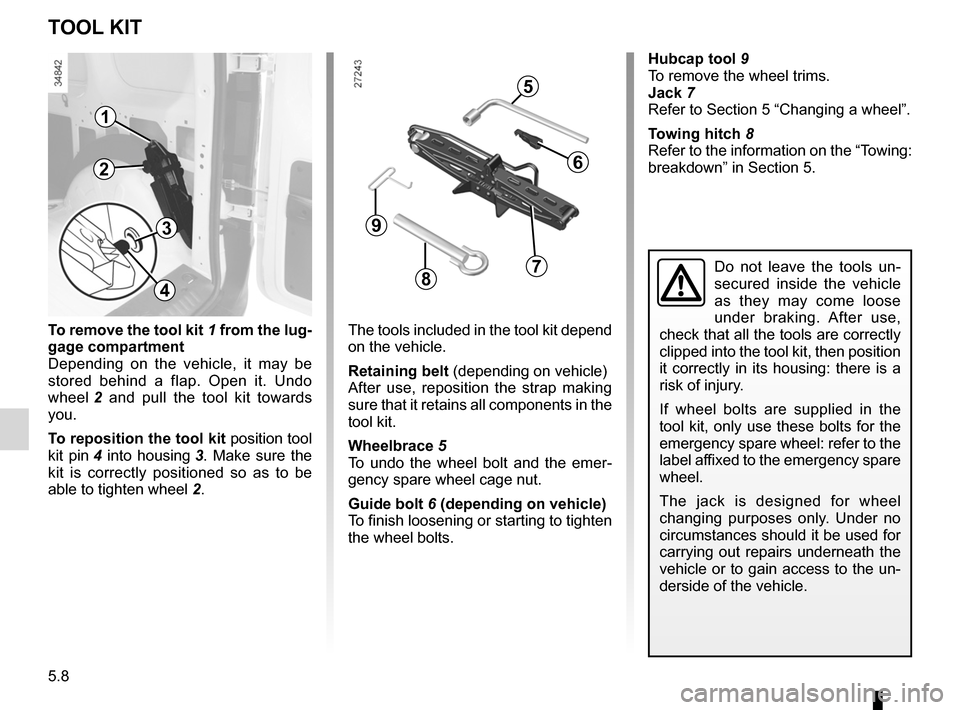
tool kit .................................................................... (current page)
hubcap tool ............................................................ (current page)
wheelbrace ............................................................ (current page)
puncture ................................................................. (current page)
jack ........................................................................ (current page)
towing hitch ............................................................ (current page)
wheelbrace ............................................................ (current page)
5.8
ENG_UD25342_5
Bloc outils (X61 - F61 - K61 - Renault)
ENG_NU_911-4_F61e_Renault_5
Tool kit
The tools included in the tool kit depend
on the vehicle.
retaining belt (depending on vehicle)
After use, reposition the strap making
sure that it retains all components in the
tool kit.
wheelbrace 5
To undo the wheel bolt and the emer -
gency spare wheel cage nut.
guide bolt 6 (depending on vehicle)
To finish loosening or starting to tighten
the wheel bolts.
t
o remove the tool kit 1 from the lug-
gage compartment
Depending on the vehicle, it may be
stored behind a flap. Open it. Undo
wheel 2 and pull the tool kit towards
you.
t o reposition the tool kit position tool
kit pin 4 into housing 3. Make sure the
kit is correctly positioned so as to be
able to tighten wheel 2.
tOOl KIt
5
6
9
1
3
2
87Do not leave the tools un -
secured inside the vehicle
as they may come loose
under braking. After use,
check that all the tools are correctly
clipped into the tool kit, then position
it correctly in its housing: there is a
risk of injury.
If wheel bolts are supplied in the
tool kit, only use these bolts for the
emergency spare wheel: refer to the
label affixed to the emergency spare
wheel.
The jack is designed for wheel
changing purposes only. Under no
circumstances should it be used for
carrying out repairs underneath the
vehicle or to gain access to the un-
derside of the vehicle.
4
hubcap tool 9
To remove the wheel trims.
Jack 7
Refer to Section 5 “Changing a wheel”.
t owing hitch 8
Refer to the information on the “Towing:
breakdown” in Section 5.
Page 158 of 213
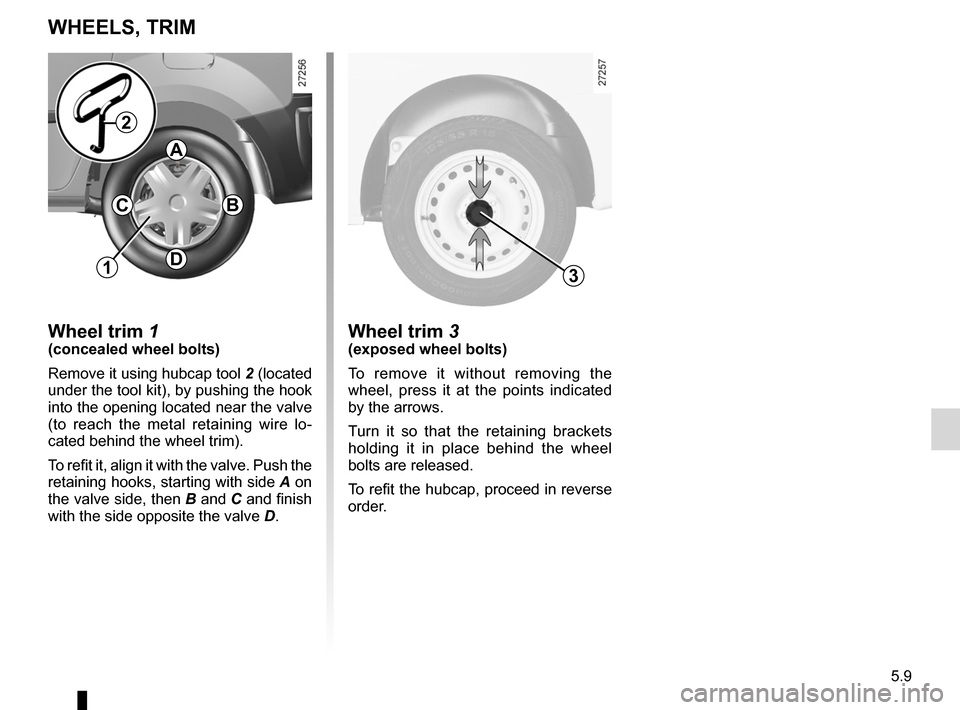
trims ...................................................... (up to the end of the DU)
5.9
ENG_UD26208_3
Enjoliveurs - Roues (X61 - F61 - K61 - Renault)
ENG_NU_911-4_F61e_Renault_5
Wheels, trim
wheel trim 3(exposed wheel bolts)
To remove it without removing the
wheel, press it at the points indicated
by the arrows.
Turn it so that the retaining brackets
holding it in place behind the wheel
bolts are released.
To refit the hubcap, proceed in reverse
order.wheel trim 1(concealed wheel bolts)
Remove it using hubcap tool 2 (located
under the tool kit), by pushing the hook
into the opening located near the valve
(to reach the metal retaining wire lo -
cated behind the wheel trim).
To refit it, align it with the valve. Push the
retaining hooks, starting with side A on
the valve side, then B and C and finish
with the side opposite the valve D.
wheels, trIm
13
a
B
D
c
2
Page 159 of 213
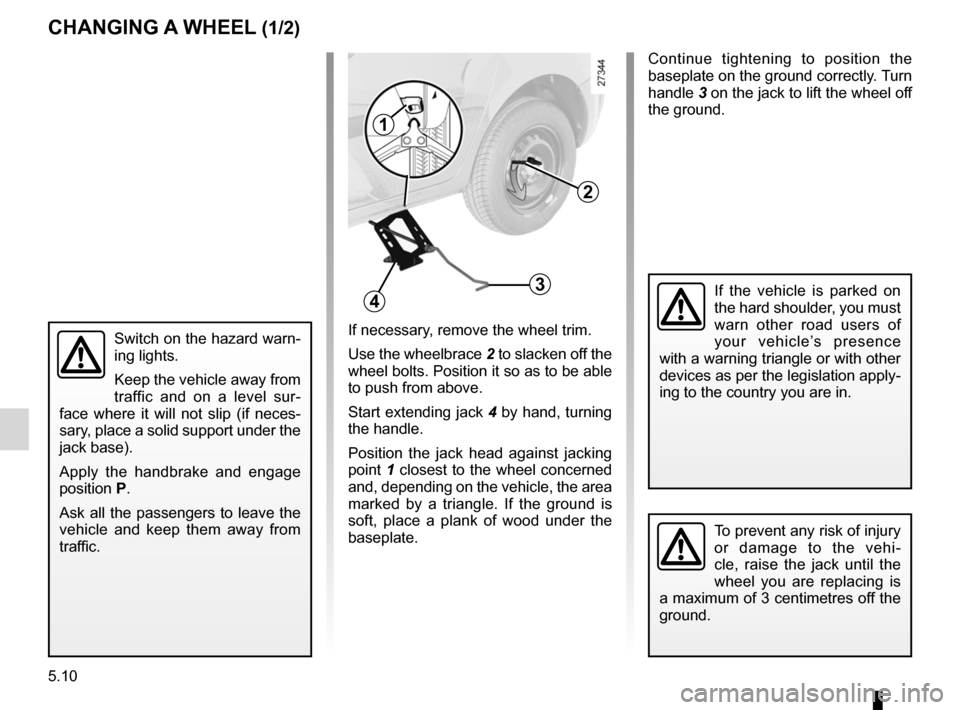
changing a wheel................................................... (current page)
puncture ................................................................. (current page)
jack ........................................................................ (current page)
lifting the vehicle changing a wheel ............................ (up to the end of the DU)
5.10
ENG_UD23719_3
Changement de roue (X61 - F61 - Renault)
ENG_NU_911-4_F61e_Renault_5
Jaune NoirNoir texte
Changing a wheel
2
4
1
3
If necessary, remove the wheel trim.
Use the wheelbrace 2 to slacken off the
wheel bolts. Position it so as to be able
to push from above.
Start extending jack 4 by hand, turning
the handle.
Position the jack head against jacking
point 1 closest to the wheel concerned
and, depending on the vehicle, the area
marked by a triangle. If the ground is
soft, place a plank of wood under the
baseplate.Switch on the hazard warn-
ing lights.
Keep the vehicle away from
traffic and on a level sur -
face where it will not slip (if neces -
sary, place a solid support under the
jack base).
Apply the handbrake and engage
position P.
Ask all the passengers to leave the
vehicle and keep them away from
traffic.
changIng a wheel (1/2)
Continue tightening to position the
baseplate on the ground correctly. Turn
handle 3 on the jack to lift the wheel off
the ground.
To prevent any risk of injury
or damage to the vehi -
cle, raise the jack until the
wheel you are replacing is
a maximum of 3 centimetres off the
ground.
If the vehicle is parked on
the hard shoulder, you must
warn other road users of
your vehicle’s presence
with a warning triangle or with other
devices as per the legislation apply-
ing to the country you are in.
Page 160 of 213
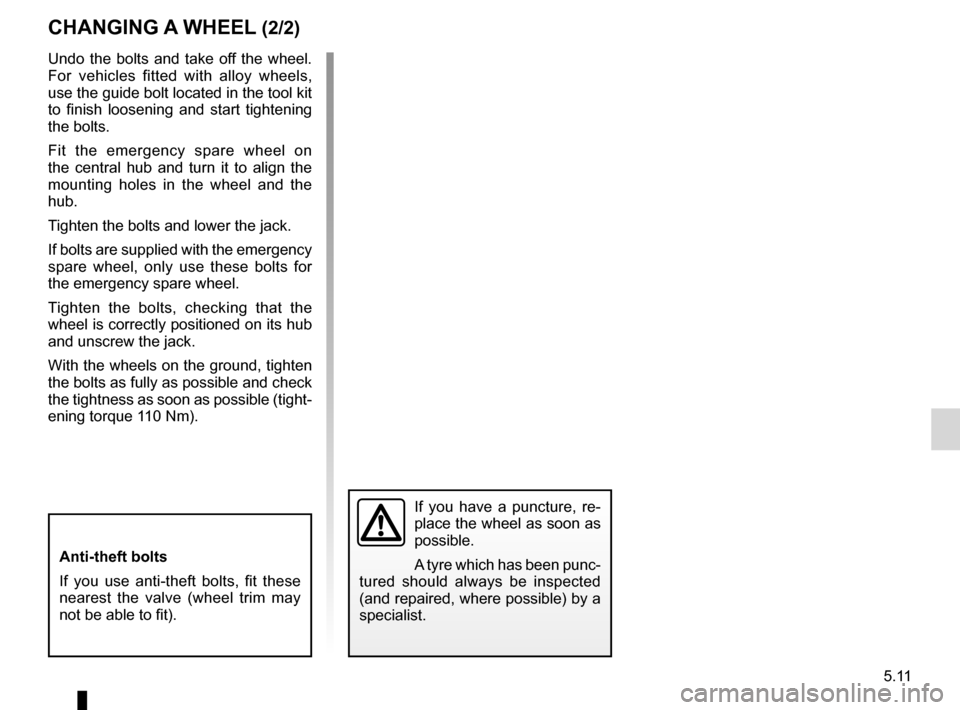
JauneNoirNoir texte
5.11
ENG_UD23719_3
Changement de roue (X61 - F61 - Renault)
ENG_NU_911-4_F61e_Renault_5
Undo the bolts and take off the wheel.
For vehicles fitted with alloy wheels,
use the guide bolt located in the tool kit
to finish loosening and start tightening
the bolts.
Fit the emergency spare wheel on
the central hub and turn it to align the
mounting holes in the wheel and the
hub.
Tighten the bolts and lower the jack.
If bolts are supplied with the emergency
spare wheel, only use these bolts for
the emergency spare wheel.
Tighten the bolts, checking that the
wheel is correctly positioned on its hub
and unscrew the jack.
With the wheels on the ground, tighten
the bolts as fully as possible and check
the tightness as soon as possible (tight-
ening torque 110 Nm).
changIng a wheel (2/2)
anti-theft bolts
If you use anti-theft bolts, fit these
nearest the valve (wheel trim may
not be able to fit).
If you have a puncture, re -
place the wheel as soon as
possible.
A tyre which has been punc-
tured should always be inspected
(and repaired, where possible) by a
specialist.